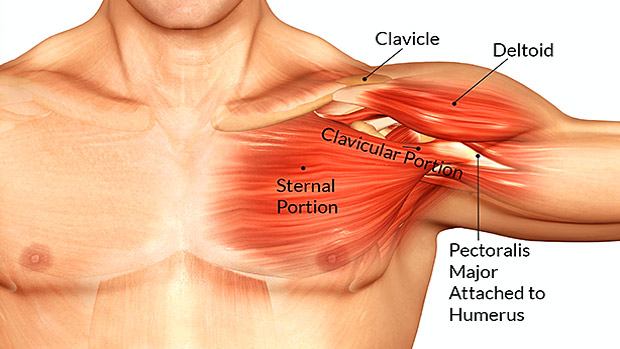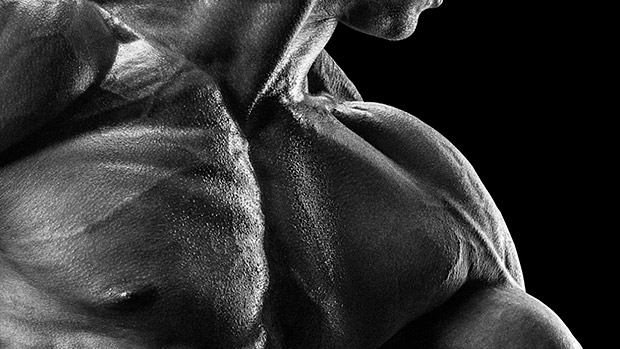While many lifters get decent mid and low-pec development, it's rare to see a truly filled-in upper chest. When it comes to aesthetics, the upper pecs are a game changer. Here are eight things you need to know (and do) to build yours.
The biggest reason guys lack upper pec development? They turn chest day into ego day. Flat bench pressing gets all the love because they can use more weight.
But if you're serious about reaching your pec potential, you need to put your ego aside and focus on incline movements – even if you train in a public gym and you currently suck at inclines.
Upper pecs are a tricky area. Unless you won the genetic lottery, just emphasizing incline pressing may not be enough.

When people think about the upper pecs, they only think about the clavicular portion of the pectoralis major. But there are TWO major portions.
The clavicular part originates on your clavicles and run almost parallel to your anterior deltoids. When doing incline presses, many lifters mistakenly use the same grip and style they use for flat bench presses. However, research shows that one great way to emphasize the clavicular portion of your pecs is to use a narrower grip when doing inclines (1).
This brings your elbows in and gets your shoulders moving in the direction of your clavicular fibers. Note: Don't bring your elbows in all the way; this will place stress on the anterior delts.
If you use a barbell, use a shoulder-width grip and focus on squeezing your hands together as you press the weight to increase the recruitment of your pecs.
You can also do this with dumbbells and your arms at a 45-degree angle:
This elbow tuck position is so powerful that you may not even need to use an incline. Research shows that simply doing flat bench press with a reverse grip lights up your clavicular fibers (2).
The downside of the reverse-grip bench press? You move your arms into external rotation. While it works, it may not be optimal because the pecs assist in internal rotation. As a result, a better approach is to press with dumbbells (off floor or bench). With dumbbells you get the same elbow position at the bottom as a reverse-grip bench press, but you can internally rotate your arms as you press up for max pec recruitment.
The other part of your pecs that's often forgotten is the upper sternal portion. If you look at the pec anatomy, you'll see sternal fibers running all the way up to the top of your sternum. If you look at the line of pull of these fibers, you'll see they're still pulling your arm across your body. If you only press with your elbows tucked, or a steep incline, you might miss this part.
To develop the upper sternal fibers, you need a low incline and a wider elbow position.
Note: If you have shoulder problems, or experience pain pressing this way, don't do it! However, if you want to give it a go, here are some tips that'll help hammer your pecs while sparing your shoulders:
Don't force the elbow flare – maintain a slight elbow tuck.
Remember, you're on a slight incline.
Flat bench pressing with wider elbows is riskier for your shoulders because your shoulders are abducted (out to the side) and internally rotated. This puts you in a position of shoulder impingement. But when you use a slight incline, you externally rotate your arms which moves you out of that shoulder impingement position.
Stop when your elbows are in line with your shoulders.
This is where most people naturally stop anyway. Also note that the distance between the dumbbells and your shoulders will vary depending on your arm length, so stop looking at the dumbbells and start looking at your elbows.
If you're trying to build your upper chest, the angle matters. If your bench angle is too high, your upper pecs will drop out and your anterior delts will take over.
What's your optimal angle? Research shows that a bench angle of about 30-45 degrees may be best for hitting your upper pecs (3). However, before you pull out your protractor, you should know that this study was done with only 14 subjects. That leaves us with the question, "What about individual variation?"
If you look carefully at a bunch of different people, you'll notice significant variance in chest cavities (sunken, flat, barrel, etc.). How can people with different chest structures press on the same bench angle and expect the same muscle activation? The optimal angle for you might be higher or lower than the next bro at your gym.
To find your best angle, try this test:
- Attach a light band to a rack or post at about eye level. Keep the band tension very light.
- Grab the band and raise your hand overhead.
- Place your opposite hand on your upper pec of the raised arm.
- Draw your hand in until it's at or just past the midline of your body.
- Slowly lower your hand.
- Stop the movement when you feel your upper pec light up.
- Turn to a side mirror and note the angle of your arm relative to your torso – that's your optimal angle.
Experiment with an adjustable bench to find the incline that best allows you to get the arm-to-torso angle from the test.
Many lifters have built tremendous pecs with flat and incline barbell presses. If they work for you, keep some barbell work in your chest training. However, dumbbells may work even better. Research comparing barbell to dumbbells shows the latter allows for better pec activation (4). Dumbbell pressing also allows your body to move naturally, placing less stress on your joints. If you have long arms, these benefits are even more noticeable.
A key function of your pecs is transverse adduction (moving your arms across your body). This can be done with low incline flyes (dumbbells or cables) or low-to-high standing cable flyes. Flyes can be especially helpful if you're more arm-dominant in your pressing – a common problem for lifters with shorter arms.
If you have longer arms or experience shoulder pain with flyes, try pressing variations that emphasize an inward motion of your hands. Depending on equipment, you may be able to do this with a machine. Another great option is doing a low-incline cross-body cable press.
If you don't have a cable stack, you can get this same motion with a one-arm low-incline press on a tilted bench. Here's how you set it up.
Use rubber coated plates on a rubber floor to reduce the risk of the plates or bench slipping.
We all know that flat bench hits mid pecs, inclines hit upper, and declines hit lower pecs, right? Well, not exactly.
One study found that while moving to a decline does increase your lower pec activation, there isn't a significant difference on upper pec activation between incline and decline bench pressing (5). Now, that is only one study and other research shows less upper pecs with declines (1).
Declines are worth experimenting with. Six-time Mr. Olympia, Dorian Yates, preferred incline and decline pressing to flat bench. If you don't normally do declines or dips, try them. If they feel okay on your shoulders, try an experiment. Do a bunch of sets of decline barbell/dumbbell presses or dips with no other pressing exercises that session.
The goal is to deliberately get sore (remember, this is for experimental purposes – not regular training). Then, over the next few days pay attention to where you feel it in your pecs. You may find that dips or decline bench is a better overall pec builder than a flat bench.
If you're specializing in your upper pecs, make these two adjustments:
1 Reduce your anterior delt work.
Despite your best efforts to isolate your upper pecs, your anterior delts will get a lot of work with any upper chest exercise. If you don't back down on front delt work, you may beat up your shoulders before you build up your upper pecs. Definitely skip front raises. If you love overhead pressing, limit it to one time per week while emphasizing your upper pecs.
2 Up your upper back work.
A strong upper back is necessary for shoulder health. It also helps pull your shoulders back so you can actually see your new pec growth.
Your upper pecs are near your androgen zone. This is the part of your body where there are more androgen receptors. While this may sound like broscience, research shows that when comparing the quads to the upper traps, there are more androgen receptors in the upper traps (6).
Based on anecdotal evidence of bodybuilders who use drugs, I'd also argue that the upper pecs and delts are also androgen-receptor dense. As a result, those using steroids will have a huge advantage in developing muscle mass in this upper torso area.
If you choose to go about this training thing "all natty" then make sure you have realistic expectations. Yes, you can build a bigger, stronger upper chest, but you won't look like your favorite pro bodybuilder.
Okay, now let's put all this together.
Day 1 – Heavy Day
| Exercise | Sets | Reps | |
|---|---|---|---|
| A1 | Closer-Grip Dumbbell or Barbell Incline Press (elbows 45 degrees) | 4-5 | 5-7 |
| A2 | Chin-Up Variation | 4-5 | 6-8 |
| B1 | Low-Incline Dumbbell Press (elbows wider) | 4 | 6-8 |
| B2 | Row Variation | 4 | 8-10 |
| C | Optional: Direct Arm Work |
Day 2 – Rep Day
| Exercise | Sets | Reps | |
|---|---|---|---|
| A1 | Dumbbell Bench or Floor Press (elbows in) | 3-4 | 8-10 |
| A2 | Pull-Up or Pulldown Variation | 3-4 | 10-12 |
| B1 | Forward Lean Cable Chest Press or One-Arm Tilted Low-Incline Press (hold and squeeze at the top for 1-2 seconds) | 3 | 10-15 |
| B2 | Row Variation | 3 | 12-15 |
| C1 | Dip (body weight) | 2 | max |
| C2 | Face Pull | 2 | 15-25 |
| D | Optional: Direct Arm Work |
Consider training your upper chest on Tuesdays and Fridays to avoid the crowds on International Chest Day.
- Barnett C et al. Effects of variations of the bench press exercise on the EMG activity of five shoulder muscles. J Strength Cond Res. 1995 Nov;9(4):222-227.
- Lehman GJ. The influence of grip width and forearm pronation/supination on upper-body myoelectric activity during the flat bench press. J Strength Cond Res. 2005 Aug;19(3):587-591.
- Lauver JD et al. Influence of bench angle on upper extremity muscular activation during bench press exercise. Eur J Sport Sci. 2016;16(3):309-16. PubMed.
- de Araújo Farias D et al. Maximal strength performance and muscle activation for the bench press and triceps extension exercises adopting dumbbell, barbell, and machine modalities over multiple sets. J Strength Cond Res. 2017 Jul;31(7):1879-1887. PubMed.
- Glass SC et al. Electromyographical activity of the pectoralis muscle during incline and decline bench presses. J Strength Cond Res. 1997 Aug;11(3):163-167.
- Kadi F et al. The expression of androgen receptors in human neck and limb muscles: effects of training and self-administration of androgenic-anabolic steroids. Histochem Cell Biol. 2000 Jan;113(1):25-9. PubMed.





